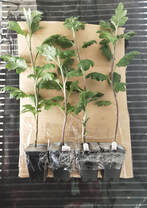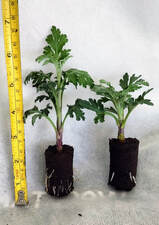What to expect when you receive your Chrysanthemum plant.
SOME TIPS TO CARE FOR CHRYSANTHEMUMS
Keep your new young plants in the SHADE for a few days to help them adjust after their journey in a cardboard box.
Chrysanthemums will grow in almost any soil type but good drainage is of the most importance.
The addition of humis materials such as manure, compost, leaf mold, or peat moss is very beneficial.
Shallow planting, no deeper that the plant was in its rooting mixture is best but the plants can be planted deeper as well.
Transplant your plant directly into it’s permanent growing position and water in well. Over the next few days do not let your plants dry out. Direct growing into garden bed then space plants approximately 40cm to 60cm apart.
Or.
Plant into pots - Pot size should be 15cm or larger using a good quality potting mix.
A little wilting is not harmful and plants usually bounce back when watered.
Cutting back - General rule is if your plants are taller than 30cm at the 10th of January then you can cut them back to about 15cm, leaving some good green foliage or growth below the cut. The result will be shorter plants and better foliage at bloom time. On large flowered cultivars, select the most vigorous growth that results after the cut and make no further stops or pinches.
Pinching - When growth resumes after cutting back, removal of the very tip growing portion of the stem will promote more branching and flowers, and in some cases help determine bloom date. Large flowered types should not be pinched after January 20th. Small flowered types can be pinched up to Februrary the 5th. An earlier pinch date will be necessary for early blooming types.
Protect from slugs and snails during wet weather. General garden sprays can be used for insects such as aphids and thrips. Yates Rose Guard, Yates Success ‘Ultra’ and GroVentive can be found at NZ hardware stores.
Want to know how to grow to enter the Chrysanthemum Flower Shows.
Contact New Zealand National Chrysanthemum Society Inc.
www.chrysanthemumsnz.weebly.com/nz-clubs-and-societies.html
Keep your new young plants in the SHADE for a few days to help them adjust after their journey in a cardboard box.
Chrysanthemums will grow in almost any soil type but good drainage is of the most importance.
The addition of humis materials such as manure, compost, leaf mold, or peat moss is very beneficial.
Shallow planting, no deeper that the plant was in its rooting mixture is best but the plants can be planted deeper as well.
Transplant your plant directly into it’s permanent growing position and water in well. Over the next few days do not let your plants dry out. Direct growing into garden bed then space plants approximately 40cm to 60cm apart.
Or.
Plant into pots - Pot size should be 15cm or larger using a good quality potting mix.
A little wilting is not harmful and plants usually bounce back when watered.
Cutting back - General rule is if your plants are taller than 30cm at the 10th of January then you can cut them back to about 15cm, leaving some good green foliage or growth below the cut. The result will be shorter plants and better foliage at bloom time. On large flowered cultivars, select the most vigorous growth that results after the cut and make no further stops or pinches.
Pinching - When growth resumes after cutting back, removal of the very tip growing portion of the stem will promote more branching and flowers, and in some cases help determine bloom date. Large flowered types should not be pinched after January 20th. Small flowered types can be pinched up to Februrary the 5th. An earlier pinch date will be necessary for early blooming types.
Protect from slugs and snails during wet weather. General garden sprays can be used for insects such as aphids and thrips. Yates Rose Guard, Yates Success ‘Ultra’ and GroVentive can be found at NZ hardware stores.
Want to know how to grow to enter the Chrysanthemum Flower Shows.
Contact New Zealand National Chrysanthemum Society Inc.
www.chrysanthemumsnz.weebly.com/nz-clubs-and-societies.html
Growers Information
The information provided is what I believe to be true for my growing situation. Bloom sizes are approximate and may vary by 1 to 2cm. Disbudding to a single bloom will produce a larger bloom.
At planting in the Spring to Summer period I pinch out the growing tip to offer what is effectively the first stop. On each cultivar listed in my gallery, I've noted the ones that need the second stop which is usually done in January. You may need to play around with the stopping dates to suit your flowering times or just leave them and let nature run its course, however this can result in very tall growing plants that will require additonal support especially near flowering. Planting from February onwards I do no pinching or stopping and let the plant run.
From a flower farming perspective, I do make a habit of supporting my Chrysanthemums using flower netting I find providing support prevents bent stems and flower heads from toppling over and dragging in the dirt, but if you intend to plant them in the garden then surrounding companion plants may provide that support.
All Chrysanthemums offer a fantastic vase life.
The information provided is what I believe to be true for my growing situation. Bloom sizes are approximate and may vary by 1 to 2cm. Disbudding to a single bloom will produce a larger bloom.
At planting in the Spring to Summer period I pinch out the growing tip to offer what is effectively the first stop. On each cultivar listed in my gallery, I've noted the ones that need the second stop which is usually done in January. You may need to play around with the stopping dates to suit your flowering times or just leave them and let nature run its course, however this can result in very tall growing plants that will require additonal support especially near flowering. Planting from February onwards I do no pinching or stopping and let the plant run.
From a flower farming perspective, I do make a habit of supporting my Chrysanthemums using flower netting I find providing support prevents bent stems and flower heads from toppling over and dragging in the dirt, but if you intend to plant them in the garden then surrounding companion plants may provide that support.
All Chrysanthemums offer a fantastic vase life.
Hi, it’s Maree here I love growing chrysanthemums, especially the heirloom types I’ve been collecting obsessively for a number of years. I aspire to grow blooms to enter into the horticultural shows which is only a very slightly different technique to growing for cut flowers.
Presently any of my spare blooms are shared with my local cut flower artists.
It’s not hard to grow Chrysanthemums for the busy home gardener or flower farmer the hardest part is remembering to do the essentials at the right times which usually can clash with the sometimes overwhelming workload of all the other Spring and Summer jobs. Make a note to remind yourself of the pinching, watering, spraying and setting up the support netting jobs. Giving your plants their first stop will help the young plants develop more branches then on most varieties I stop again about the first week of January this is for the ones under cover if growing outside it’s about a week later before I get to them.
Having a regular spray programme can be advantageous for the control of insects such as aphids, mites and fungal problems. Any of your general garden spray products will work and it is better to alternate between products. The control of slugs is also worth doing, especially in Spring or when the plants are small and then again in autumn to protect the young stools that will be trying to push through the soil surface. Chrysanthemums will grow in any good garden free draining soil. A side dressing of fertiliser throughout the growing season will have favourable results with plant health, bloom quality and the development of the underground stools. Disbudding can be started as soon as the buds appear, sweeping through the growing area daily to remove the side buds and leaving the main top bud. If you don't get a chance to disbud these plants still make wonderful usable sprays. Have fun experimenting with disbudding.
Currently, I’m making my study to note which varieties flower in what week and month so as to be able to offer a constant supply of blooms. I’m working on getting more earlier flowering varieties together bringing about the possibility of supplying chrysanthemum blooms from December through to May. Heaven on earth don’t you think!
Would you like to receive an email order form as the plants become available?
Presently any of my spare blooms are shared with my local cut flower artists.
It’s not hard to grow Chrysanthemums for the busy home gardener or flower farmer the hardest part is remembering to do the essentials at the right times which usually can clash with the sometimes overwhelming workload of all the other Spring and Summer jobs. Make a note to remind yourself of the pinching, watering, spraying and setting up the support netting jobs. Giving your plants their first stop will help the young plants develop more branches then on most varieties I stop again about the first week of January this is for the ones under cover if growing outside it’s about a week later before I get to them.
Having a regular spray programme can be advantageous for the control of insects such as aphids, mites and fungal problems. Any of your general garden spray products will work and it is better to alternate between products. The control of slugs is also worth doing, especially in Spring or when the plants are small and then again in autumn to protect the young stools that will be trying to push through the soil surface. Chrysanthemums will grow in any good garden free draining soil. A side dressing of fertiliser throughout the growing season will have favourable results with plant health, bloom quality and the development of the underground stools. Disbudding can be started as soon as the buds appear, sweeping through the growing area daily to remove the side buds and leaving the main top bud. If you don't get a chance to disbud these plants still make wonderful usable sprays. Have fun experimenting with disbudding.
Currently, I’m making my study to note which varieties flower in what week and month so as to be able to offer a constant supply of blooms. I’m working on getting more earlier flowering varieties together bringing about the possibility of supplying chrysanthemum blooms from December through to May. Heaven on earth don’t you think!
Would you like to receive an email order form as the plants become available?




